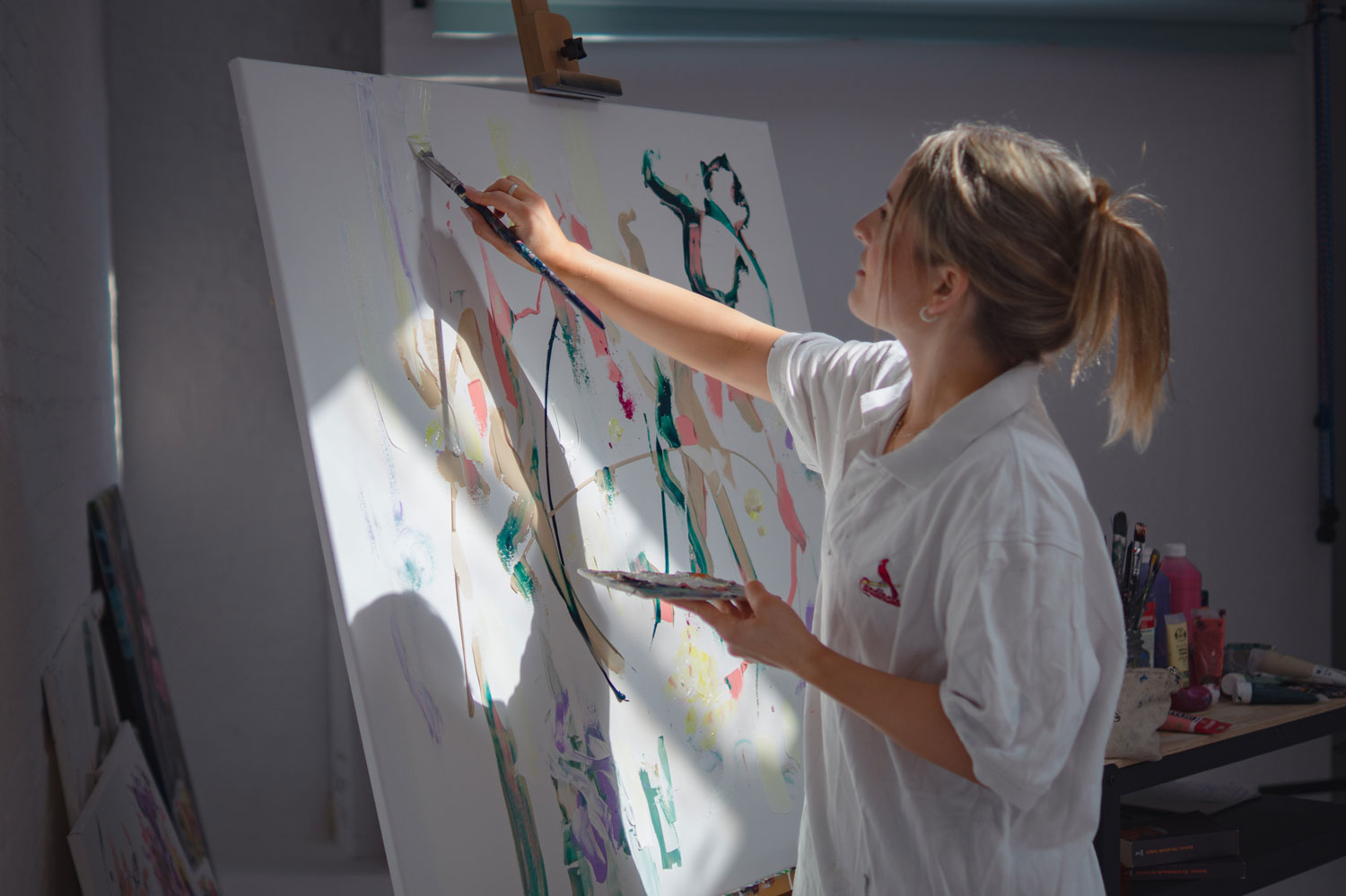Vision
»Meine Kunst durchbricht Denkmuster, hinterfragt Wahrnehmung und bringt Menschen in Resonanz. In einer konstruierten Welt soll sie Reflexion auslösen und den Blick für das Wirkliche schärfen.«
»My art disrupts conventional thinking, challenges perception, and resonates with people. In a constructed world, it aims to spark reflection and sharpen the eye for what is real.«

Foto: ©Nils Strothoff

Foto: ©Nils Strothoff
Künstlerinnenstatement
Ich betrachte die Welt nicht als gegeben, sondern als gemacht – voller Strukturen, Normen und Bilder, die selten hinterfragt werden. Mein künstlerischer Impuls entspringt genau dort: im Zweifel, im Staunen, im Bedürfnis, diese scheinbare Ordnung aufzubrechen.
Meine Arbeitsweise ist medienübergreifend und prozessorientiert, oft mit Elementen, die Gegensätze verbinden: Intuition und Konzept, Körperlichkeit und Abstraktion, Lautes und Leises. Dabei geht es mir nie um die reine Form, sondern um das, was sich hinter ihr verbirgt. Meine Kunst stellt Fragen – an die Welt und an die, die sie betrachten.
In einer Zeit, in der Realität zunehmend zur Konstruktion wird, verstehe ich meine künstlerische Praxis als ein Angebot zur Rückverbindung: mit dem Wirklichen, mit dem Zweifel, mit sich selbst.
I don't see the world as a given, but as something made—shaped by structures, norms, and images that are rarely questioned. My artistic impulse arises precisely there: in doubt, in wonder, in the urge to disrupt this apparent order.
My practice is cross-media and process-oriented, often weaving together opposites: intuition and concept, physicality and abstraction, the loud and the quiet. I'm never driven by form alone, but by what lies beyond it. My art asks questions—of the world and of those who engage with it.
In a time when reality is increasingly becoming a construction, I see my artistic practice as an invitation to reconnect: with what is real, with doubt, and with oneself.
Ich betrachte die Welt nicht als gegeben, sondern als gemacht – voller Strukturen, Normen und Bilder, die selten hinterfragt werden. Mein künstlerischer Impuls entspringt genau dort: im Zweifel, im Staunen, im Bedürfnis, diese scheinbare Ordnung aufzubrechen.
Meine Arbeitsweise ist medienübergreifend und prozessorientiert, oft mit Elementen, die Gegensätze verbinden: Intuition und Konzept, Körperlichkeit und Abstraktion, Lautes und Leises. Dabei geht es mir nie um die reine Form, sondern um das, was sich hinter ihr verbirgt. Meine Kunst stellt Fragen – an die Welt und an die, die sie betrachten.
In einer Zeit, in der Realität zunehmend zur Konstruktion wird, verstehe ich meine künstlerische Praxis als ein Angebot zur Rückverbindung: mit dem Wirklichen, mit dem Zweifel, mit sich selbst.
I don't see the world as a given, but as something made—shaped by structures, norms, and images that are rarely questioned. My artistic impulse arises precisely there: in doubt, in wonder, in the urge to disrupt this apparent order.
My practice is cross-media and process-oriented, often weaving together opposites: intuition and concept, physicality and abstraction, the loud and the quiet. I'm never driven by form alone, but by what lies beyond it. My art asks questions—of the world and of those who engage with it.
In a time when reality is increasingly becoming a construction, I see my artistic practice as an invitation to reconnect: with what is real, with doubt, and with oneself.

Foto: ©Nils Strothoff
Ich fand zur Kunst, als ich begann, Wahrnehmung nicht länger als gegeben hinzunehmen. Und ich blieb, weil sie mit mir in Resonanz trat – tief, ehrlich und transformierend.
In einer Welt, die zunehmend nach Konstruktion, Simulation und Täuschung riecht, möchte ich mit meiner Kunst das Gegenteil bewirken: Echtheit provozieren. Reflexion auslösen. Das Wirkliche sichtbar machen.
I found my way to art when I stopped accepting perception as a given. And I stayed because it resonated with me—deeply, honestly, and transformatively.
In a world that increasingly reeks of construction, simulation, and illusion, my aim is the opposite: to provoke authenticity. To spark reflection. To make what is real visible.
In einer Welt, die zunehmend nach Konstruktion, Simulation und Täuschung riecht, möchte ich mit meiner Kunst das Gegenteil bewirken: Echtheit provozieren. Reflexion auslösen. Das Wirkliche sichtbar machen.
I found my way to art when I stopped accepting perception as a given. And I stayed because it resonated with me—deeply, honestly, and transformatively.
In a world that increasingly reeks of construction, simulation, and illusion, my aim is the opposite: to provoke authenticity. To spark reflection. To make what is real visible.


